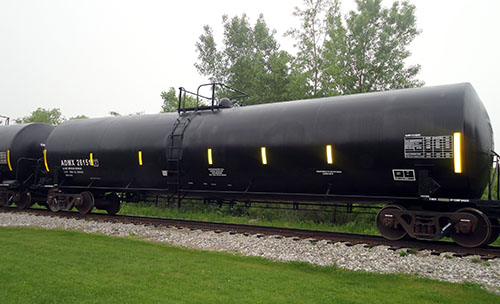
An ADM railcar painted with new Soyathane paint.
By Emery Styron
news@corridorbusiness.com
Terms like “green” and “farm-to-market” are getting extra mileage these days at Archer Daniels Midland’s Cedar Rapids railcar facility. Crews there are painting hopper and tank cars with a new, non-toxic coating made from a Iowa commodity many of them carry: soybeans.
ADM has been testing Soyathane water-based urethane paint with good results since last spring and expects to put it on more than 400 railcars this year, according to Tim Palmer, paint and blast supervisor for the railcar facility. The paint was chosen for performance, safety and environmental reasons; the fact that it also contains ADM’s soy-based CA 118 Low-VOC Coalescent and a resin made from ADM soy products is an extra bonus. “Job security,” Mr. Palmer calls it.
The U.S. Department of Agriculture and the United Soybean Board (USB) are betting that biobased products like Soyathane will provide stronger markets for farmers, and growth opportunities for ADM and other processors. The USDA oversees the USB’s research on chemically modifying soybean oil to create components for paints and other coatings. It also promotes ag-based products as greener, healthier alternatives via its BioPreferred program.
Health concerns spurred Bipacco Coatings owner Tony Brady to create Soyathane. In 2012, Mr. Brady recovered from removal of a brain tumor he attributes to 30 years of working with solvents. He set technicians at his Cuba, Missouri plant to work formulating a new product using ADM’s CA 118 and a paint resin derived from soybeans and manufactured by Reichhold Chemicals, an ADM customer.
The result: a non-toxic, heavy metal-free, low-VOC, water-based paint that earned USDA BioPreferred certification last June. VOCs, or volatile organic compounds, are emitted as gases from certain solids or liquids. They contain a variety of chemicals, some of which may have short- and long-term adverse health effects, according to the EPA. Those effects can range from eye, nose and throat irritation, to liver, kidney and central nervous system damage and cancer, the agency says.
ADM was painting its cars with a two-part epoxy, but “we wanted something greener and more environmentally-friendly,” Mr. Palmer said. He was willing to listen to a pitch from Mr. Brady, who also supplies paint for ADM tugboats and barges.
The paint’s non-toxicity and minimal VOCs were selling points. It performed well in tests on two cars, so ADM ordered more. It’s been using the paint since last summer.
ADM’s railcars haul all kinds of products, from commodities like corn, beans and oats, to refined goods like corn syrup, seed oils and starches. How often they’re painted depends on exposure to the elements, graffiti and derailments, but generally it’s every 10 years, Mr. Palmer said. Painting requires 25-30 gallons per car.
“We liked the results and the way it sprayed,” said Mr. Palmer. “We feel the longevity of it is going to work well for us.”
If Soyathane continues to perform, it could be a win-win arrangement for ADM and Bipacco. Mr. Brady hopes to take the new paint to a wider market as customers recognize its health and environmental advantages.
“It brings ‘farm-to-market with organic formulation’ a whole new meaning,” he said.
Timing is certainly working in their favor. A USDA study found that biobased products added $369 billion to the economy and created more than 4 million part- and full-time jobs in 2013, the most recent year figures were available. Of that, biobased paint and coating manufacturing accounted for $334 million and 1,590 jobs. USDA predicts employment related to biobased products will grow from nearly 4.8 million jobs this year to more than 5.3 million jobs by 2020.
Iowa also boasts the nation’s highest location quotient, 8.680, for grain biorefining and oilseed milling. That figure is based on employment in the sector, and means that Iowa is about 8.7 times more likely to export biorefined grain products and oilseed products than other areas of the country. The state currently has more than 40 ethanol plants, and Cedar Rapids has long been a leader in processing agricultural commodities into food ingredients and manufacturing materials.
Some legislators now see the potential for a bigger economic boost by attracting more biochemical manufacturers to set up in the state. Bills have been introduced in the Iowa House and Senate this session to enact a state tax credit to encourage the development of biochemical production facilities in Iowa.




